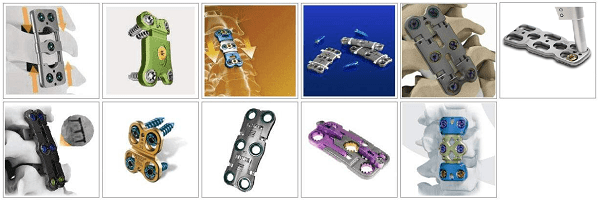In the early 1950s, Bailey and Badgley performed the first anterior cervical fusions. After them, Cloward, Smith and Robinson perfected the techniques of cervical fusion although in those early days they had high rates of pseudoarthrosis and kyphosis. Years later, in 1964 Bohler developed the first internal cervical fixation system that ushered in the era of cervical plates. From the beginning, the Anterior cervical plating systems were designed to augment spinal stability and to reduce graft-related surgical complications until bony fusion occurs.
Over the past 20 years, the design of cervical plates has improved in quality and characteristics, with new concepts appearing such as semiconstrained rotational and translational systems and multiconstruct systems. In the early 2000s, a new generation of translational plates such as the Vectra T or Atlantis T appeared on the market led by the pioneering ABC from Aesculap.Today its use and interest have fallen enormously. Only a few companies maintain a translational cervical plate in their product portfolio.
What are Translational Cervical Plates?
Translational plates were designed to provide translation and rotation at the screw–plate interface. Movement at the screw–plate interface was planned to avoid stress shielding so that, theoretically, fusion rates would increase and time to fusion would diminish. This concept follows the Wolff law, which suggests that loading alters bone integrity and bone healing, that is, bone heals more optimally when exposed to a compressive load.
Wolff’s Law (Julius Wolff, 1836-1902) states that:
“Every change in the function of a bone is followed by definitive changes in its internal architecture and secondary alterations in its external confirmation.”
This means that osseous tissues remodel in direct response to the stresses placed upon them.
Which is the Philosophy of Dynamic Plating?
Dynamic or translational plates are designed to allow axial settling so as to maintain load sharing on the graft. Such settling can occur due to graft resorption, graft subsidence into the end plate or imperfect graft and end-plate contact. A dynamic plate allows load to continue to be applied to the graft even after subsidence occurs to assist in obtaining a sound fusion. With internally-dynamized plates, the screws can remain fixed in the vertebral bodies, while the plate compresses. This is in contrast to the “slotted” dynamic plates in which the screws can move within the plate, which may allow the plate to potentially impinge on the adjacent disc. (Source: Stryker)
Today in our section T-ACP (Translational Anterior Cervical Plates) we have included the most important Translational plates. Some of them are no longer in the market since this type of dynamic devices are not a trend anymore.

The 10 Devices included in our T-ACP (Translational Anterior Cervical Plates) section are the following :
- ABC2 E-Plate
- Active Dynamic Plate
- Atlantis Translational
- AntCer II
- DynaTran®
- KINETIC-SL
- Mambo® modular cervical plate system
- Pyrenees Translational
- Rhausler Anterior Cervical Vertebrae Plate System
- UNIFY® anterior cervical plate system
- Vectra-T
All video parts, images and documents related to the products are of the sole property of the different companies.All the information is for Educational purpose only! No copyright infringement intended.We encourage you to contact us if you have any comment, suggestion or if you want us to include/remove your videos, images or brochures. Please contact us: [email protected]
